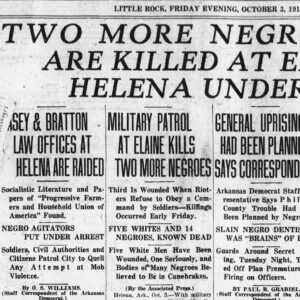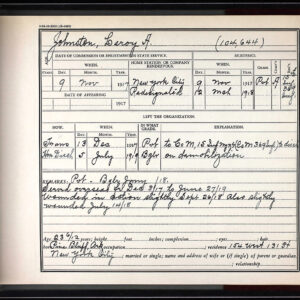calsfoundation@cals.org
Leroy Alfred Johnston (1893?–1919)
Leroy Alfred Johnston was a World War I veteran who received the Croix de Guerre and who posthumously received the Purple Heart in 2018 after it was discovered that his service records had been deliberately altered. He and his three brothers were murdered during the Elaine Massacre of 1919.
Leroy Alfred Johnston was born on April 2, 1893 or 1894, in Pine Bluff (Jefferson County). In the 1900 federal census, Johnston’s date of birth was listed as April 1893, but on his military records, his date of birth was listed as April 2, 1894. Johnston was the son of the Reverend Lewis Johnston Jr. (1847–1903), who was a native of Pennsylvania, and Mercy Ann Taborn Johnston (1848–1927), a native of North Carolina. He had five known siblings. His father was the first ordained black minister of the Covenanter Church and served in the United States Colored Troops during the Civil War. His mother was a teacher and later became an undertaker in Muskogee, Oklahoma. His parents also founded the Richard Allen Institute, one of the earliest Presbyterian schools for African Americans in Arkansas, in Pine Bluff in 1886.
Johnston enlisted in the National Guard in New York City on November 9, 1917. He served with New York’s Fifteenth National Guard, which was later renamed the 369th Infantry Regiment and nicknamed the “Harlem Hell Fighters” by German soldiers. Johnston was assigned to Camp Whitman in New York for basic military practice. He was assigned to Camp Wadsworth in Spartanburg, South Carolina, for combat training and then shipped to France in late 1917.
Johnston served as a bugler in Company M, Third Battalion, of the 369th Infantry. The Harlem Hell Fighters were assigned to the French Army on April 8, 1918. They spent 191 days under fire, suffered some of the highest regimental casualty rates in the Meuse-Argonne Offensive, and were one of the first African-American regiments to engage in combat. They wore green United States uniforms but used French-issued weapons and supplies.
Johnston was wounded in July 1918 at the Battle of Chateau-Thierry and severely wounded on September 26, 1918, during the Meuse-Argonne Offensive; he had to crawl back on his hands and knees to reach an aid station. He was so severely wounded that he was not able to come back with his regiment when it returned home. Johnston was one of 171 members of the 369th Infantry Regiment that France awarded the Croix de Guerre (Legion of Honor).
Corporal Johnston departed from Marseille, France, on June 12, 1919; arrived in New York on June 27, 1919; was honorably discharged on demobilization on July 5, 1919; and returned to Phillips County on August 8, 1919.
On October 2, 1919, while returning home from hunting with his brothers—Dr. D. A. E. Johnston, Gibson Allen Johnston, and Dr. L. H. Johnston—he and his brothers were arrested in Elaine (Phillips County). Sources vary as to the exact events that followed next, but Johnston and his brothers were shot by posse members, and their bodies were dumped on the side of the road. Some black newspapers, including the Crisis and Tulsa World, also reported that the bodies of the Johnston brothers were held for ransom until their mother, Mercy Johnston, paid the money in order to bury her sons. Although some books and black newspapers claim that the Johnston brothers were buried in Little Rock (Pulaski County), according to the Pine Bluff Daily Graphic, the Arkansas Democrat, and the Arkansas Gazette, their bodies were brought back to their childhood hometown of Pine Bluff for their funerals and burial.
Due to alterations on his service records in which “severely” wounded was typed over and changed to “slightly” wounded, Johnston was denied his Purple Heart or any awards for being wounded in action. An investigation by University of Arkansas at Little Rock professor Brian K. Mitchell brought this to light, and on November 16, 2018, Johnston’s family members received his Purple Heart; his World War I Victory Medal with France’s Service Clasp, Champagne-Marne Clasp, Aisne-Marne Clasp, and Meuse-Argonne Battle Clasp; and his World War I Victory Button.
For additional information:
Field, Hunter. “Medals Due for Black War Hero from Arkansas Killed in 1919 Massacre.” Arkansas Democrat-Gazette, October 8, 2018, pp. 1A, 2A. Online at https://www.arkansasonline.com/news/2018/oct/08/medals-due-for-massacre-victim-20181008/ (accessed July 24, 2019).
“Lived at Pine Bluff: Bodies of Four Johnston Brothers Taken There for Burial.” Arkansas Gazette, October 4, 1919, p. 3.
Lockwood, Frank E. “Blacks’ WWI Valor Gets Another Look.” Arkansas Democrat-Gazette, October 15, 2018, pp. 1B, 2B. Online at https://www.arkansasonline.com/news/2018/oct/15/blacks-wwi-valor-gets-another-look-2018/ (accessed July 24, 2019).
“World War I Vet Who Was Killed in Massacre in Arkansas to Be Awarded Purple Heart.” Arkansas Democrat-Gazette, September 14, 2018. Online at https://www.arkansasonline.com/news/2018/sep/14/wwi-vet-who-was-killed-massacre-arkansas-be-awarde/ (accessed July 24, 2019).
Gwendolyn L. Shelton
Pine Bluff, Arkansas
 Early Twentieth Century, 1901 through 1940
Early Twentieth Century, 1901 through 1940 Elaine Massacre Headlines
Elaine Massacre Headlines  Johnston Military Record
Johnston Military Record 




Comments
No comments on this entry yet.